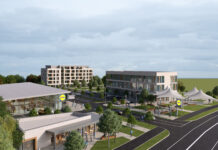
DUBLIN Airport’s monopoly should be tackled in the best interest of Shannon, the wider region it serves and other regions outside the Dublin economic corridor.
That was the considered view of two leading economists at Limerick Chamber’s first ‘Economic Outlook’ event of the year.
Chamber economist Dr. Catriona Cahill and Associate Professor of Economics at the University of Limerick Stephen Kinsella entered the debate on Dublin Airport’s unhealthy dominance of the aviation market by stating there are now clear grounds for specific supports for Shannon Airport.
Addressing almost 200 business people at the breakfast briefing sponsored by the Limerick Post, Dr. Cahill said that while there has been considerable growth achieved in the Mid West region over recent years, connectivity is one of the key areas of concern.
She said that Shannon is under pressure on two fronts – principally from Dublin Airport as it mops up 96 per cent of all new passengers coming into Ireland, but also from ‘regional’ airports such as Knock and Kerry which can avail of grants that Shannon can’t because of its status as a ‘state airport’.
“Air access is critical for economic growth and airports play a pivotal role in attracting foreign direct investment. The importance of airports is recognised in Project Ireland 2040 but despite this, there is a very worrying trend of Dublin’s increasing dominance.
Shannon last year achieved 1.86 million passengers but has the capacity to serve many more and act as a counterbalance to the Dublin Airport Authority (DAA) monolith.
“Under EU legislation any airport with passenger numbers of under three million can qualify for state funding. Shannon airport meets this requirement yet the State has elected not to support Shannon in this manner due to its status as a state-owned airport.
“This gives other privately-owned regional airports an unfair advantage. For example, European legislation recently came into effect requiring security upgrades that came in at a cost of €10 milion at Shannon whereas these upgrades at Knock and Kerry airports are in the main being funded by the Department of Transport.
“Also, Tourism Ireland has a budget of €45million this year to market Ireland. The promotion of air access is an important aspect of this outlay. Despite its dominance, airlines seeking to develop routes from Dublin airport can avail of funding. There is no transparency with regards to the distribution of these funds. This needs to change and priority must be given to the promotion of air access outside of the capital.
She said that the region also has a second key transport asset in Shannon Foynes Port Company and it, too, needs support for its Limerick Docklands Framework Strategy for maximising commercial productivity there as well as capitalising on non-core assets.
“There is also the need to expedite the new road to Foynes, which is a port of national and EU significance because of its deep water, while there is also a need to advance the rehabilitation of the Limerick to Foynes rail link” Dr Cahill stated.
UL economist Dr. Stephen Kinsella said that Shannon has a special case for funding supports due to the impact of Brexit.
“Brexit, in addition to being an existential threat to the Mid-west in agri-food production and obviously manufacturing, is also a big threat to our regional airport, Shannon, because it has its major hub into Heathrow.
“This might be to our disadvantage. In that case we’ll need to see a package of supports for Shannon and that package of support will have to be comprehensive.”
Professor Kinsella said that the current spread of passenger growth into Ireland, with Dublin Airport grabbing 96 per cent, is not sustainable.
“We should not accept that. It doesn’t need to be the case that 96 per cent of all increase in traffic goes to Dublin (airport) and the other 4 per cent is split between the regional airports.
“We don’t need to accept that at all. A policy of proper balanced regional development means not everything goes in one place. The government’s adopted and preferred strategy is balanced growth and balanced regional development,” he said.











